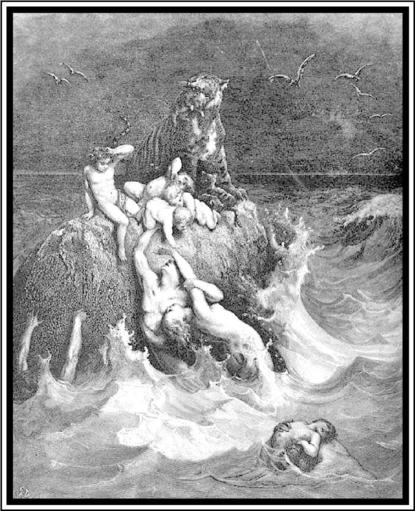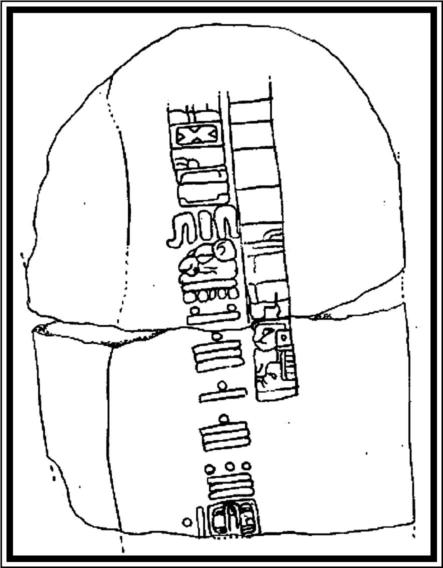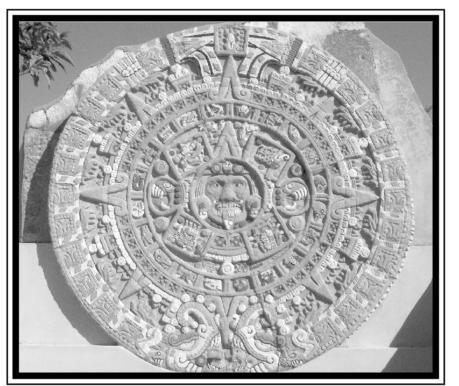Hidden History: Lost Civilizations, Secret Knowledge, and Ancient Mysteries (32 page)
Read Hidden History: Lost Civilizations, Secret Knowledge, and Ancient Mysteries Online
Authors: Brian Haughton
Tags: #Fringe Science, #Gnostic Dementia, #U.S.A., #Alternative History, #Amazon.com, #Retail, #Archaeology, #History

The stone anchors have been explained by Armenian archaeologists as
pre-Christian Armenian stelae (standing stones) recarved in the Christian
period, probably between A.D. 301 and
406. The rock specimens containing
Wyatt's so-called petrified wood were
later examined by geologists, and no
trace whatsoever of wood was found.
As for the metal artifacts, they proved
to be naturally occurring pieces of iron
oxide. When the site was reexamined
in 1987 using ground penetrating radar, the results again indicated a feature geological in nature.
In 1993, CBS in America aired a
documentary made by Sun International Pictures entitled The Incredible
Discovery of Noah's Ark. In this program, George Jammal, an Israeli actor living in Long Beach, California,
claimed to possess a piece of ancient
timber from Noah's Ark. The show was
apparently watched by 40 million viewers, who naturally assumed that it was
a serious documentary about the biblical Noah's Ark. Later, Jammal admitted that the story was a complete hoax
and that he had never even been to
Turkey. The ancient timber, which the
researchers on the documentary had
never even bothered to have tested,
was actually a piece of wood taken from
the railroad tracks near his workplace
in Long Beach. More recently, Daniel
McGivern of the Hawaii Christian Coalition, claimed to have discovered the
ark on satellite pictures of Mount
Ararat. He stated that he was "98 percent sure" that it was the ark, and one
image even showed the actual beams
of wood on the vessel.
In 2004, McGivern announced a
much publicized $900,000 expedition
to Ararat, to take place that July, to
prove that the Ararat anomaly, as the
image has become known, is actually
Noah's Ark. McGivern was subsequently refused permission to enter
the area by the Turkish government
as the summit of Ararat is inside a restricted military zone. But some suspected that this proposed expedition
had not been genuine anyway. The choice of Ahmet Ali Arslan, an English
professor at Seljuk University in Turkey, as expedition leader, caused many
searchers for the ark to become suspicious. Arslan had previously been involved in the hoax documantary aired
by CBS in 1993, and has also been accused of faking photographs of the ark.
Many now consider McGivern's abortive $900,000 expedition to have been
a publicity stunt. Nevertheless, despite the numerous hoaxes and exaggerations surrounding the subject, and
the repeated failures to find any physical evidence of the Ark, many still believe the story of Noah's Ark is the
literal truth, and that one day its remains will be located in the region of
Ararat.
The legend of a great flood and a
specially chosen hero who lives
through it to bring new life to the world
is not confined to the Bible. The story
has parallels in many mythologies of
the ancient world, and shares numerous features with accounts in Assyro-
Babylonian mythology in particular.
The best known of these is the Epic of
Gilgamesh, a story originating from
Babylon, but in its most complete version preserved on clay tablets from the
collection of the seventh century B.C.
Assyrian king named Ashurbanipal.
The earliest Sumerian (from southern
Mesopotamia) modern day versions of
the epic date back to the third dynasty
of Ur (2100 B.c.-2000 B.c.). The tale
tells of Ellil, chief of the gods, who is
about to destroy mankind with a flood.
A man named Utnapishtim is warned
by the god Ea (the god of water) of this
forthcoming deluge and instructed to
pull down his reed dwelling and construct a great boat or ark to save himself. He is to fill this ark with his
family and representatives of each
species of animal. After a ferocious
seven-day storm and 12 days floating
around on the floodwaters, the ship
comes to ground on Mount Nisir. Waiting seven days, Utnapishtim releases
a dove which comes back, then a swallow, which also returns, and finally
sends out a raven, which does not come
back. Utnapishtim then makes a sacrifice to the god Ea and he and his wife
are granted immortality. The similarities with the biblical flood story are
plainly obvious, but is there any archaeological evidence that such a
world flood actually took place at some
time in the remote past?

The Deluge by Gustave Dore.
There is certainly a considerable
amount of evidence for prehistoric
flooding in Mesopotamia, an area that
included parts of modern day Iraq,
Turkey, and Syria. (For example, at
the site of Ur, on the Persian Gulf, in southern Mesopotamia.) In his 1999
book Noah's Ark and the Ziusudra
Epic: Sumerian Origins of the Flood
Myth, Robert M. Best cites a six-day
flood on the Euphrates River around
2900 B.c. as an explanation of the biblical deluge. His ingenious theory is that
Noah was actually a historical person
called Ziusudra, a king/priest of the
Sumerian city-state Shuruppak. He
suggests that Ziusudra and his family were swept down the Euphrates
River into the Persian Gulf on a kind
of commercial river barge. They were
then set adrift for almost a year
before eventually grounding in an
estuary near the mouth of the river.
This particular flood has been archaeologically confirmed, but again, it
was a local river flood, not a global inundation.
Another flood theory has been put
forward by Walter Pitman and William Ryan, two geologists at Columbia
University in New York. In their book,
Noah's Flood, published in 2000, Pitman and Ryan claim that the biblical
account of Noah's flood is based on a
cataclysmic flooding of the Black Sea,
which took place in the early Neolithic
period, about 5600 B.c. The Black Sea,
then a freshwater lake, was flooded
when the level of the Mediterranean
Sea rose at the end of the last ice age,
and millions of gallons of its waters
poured through the narrow Bosporus
Strait. The Black Sea rapidly filled
and overflowed into large parts of the
surrounding area. It has been estimated that the low-lying land around
the lake would have vanished at the
incredible rate of about a mile per day.
At the time of this great catastrophe
there would have been a considerable
agricultural population inhabiting the
area, who would have had to flee for
their lives as a result of this great deluge. Such a cataclysmic occurrence
would certainly have etched itself into
people's memory, and would subsequently have been handed down from
generation to generation, probably
with various mythical elements being
added over time, until it attained the
form we recognize today. Although
such an explanation does not by any
means prove the literal truth of the
biblical flood story, it does provide a
catastrophic event upon which many
of the flood stories found in the mythology of Near Eastern civilizations,
may have been based.


Drawing of the back of Stela C, from the archaelogical site of Tres Zapotes. This stone
shows the oldest Mayan-style long-count date yet unearthed, equivalent to September 3,
32 B.C. in our present-day calendar.
The Maya were a remarkably sophisticated Meso-American civilization whose territory included present
day Guatemala, Belize, Honduras, El
Salvador, and the southeastern Mexican states of Tabasco, Yucatan, and
Quintana Roo. The six centuries from
about A.D. 250 to 900 was the Classic
period of Mayan culture, when their
artistic and intellectual achievements
were the equal of any pre-Columbian
civilization in the Americas. The Maya
were the first people of the Americas
to keep historical records, most of
which adorned stelae (stone monuments), and contain records of civil
events and Mayan calendric and astronomical knowledge. Perhaps the supreme example of the Mayan's cultural accomplishments is their extraordinarily intricate calendar system,
which had a major influence on the
later Aztec calendar. This calendar has
become ominously significant in the
early 21st century as, according to one
reading of its dates, on the winter solstice (around the 21st of December) in
2012, there will be a catastrophic flood
and the world will be destroyed.
Calendars are generally based on
astronomical events, such as the cycles
of the sun, moon, planets, and stars.
Ancient civilizations depended on the
perceived movement of these bodies
across the sky to establish their seasons, months, and years, with priestastronomers pronouncing the advent
of a new period. Such calendars were,
and still are, used to organize farming, hunting, and migrating activities,
as well as to determine dates for religious and public events. One of the
first cultures to create a calendar were
the Sumerians, who inhabited southern Mesopotamia around 5,000 years
ago. The Sumerian calendar, later
inherited by the Babylonians, divided
the year into 30-day months, separated
the day into 12 periods (each one
equivalent to two hours), and split
these periods into 30 parts (each equal
to four minutes).

Photograph by Ancheta Wis. (Creative Commons Attribution-ShareAlike License v. 2.5).
Aztec Stone of the Sun replica in El Paso, Texas. The stone, based in part on the Mayan
Calednar, represents how the Aztecs measured days, months, and cosmic cycles.
The original Egyptian calendar
seems to have been derived from the
cycles of the moon, but was later replaced when the Egyptians noticed
that the Dog Star (Sirius, in the constellation Canis Major), rose with the
sun every 365 days, preceding the annual flooding of the Nile by a few days.
Based on the knowledge of the heliacal rising of Sirius, they instituted a
365 day calendar that seems to have
begun in 4236 B.C., possibly the first
recorded date in history. The Egyptian
year consisted of 12 months of 30 days
each, as well as five additional days at
the end of the year. Their months were
divided into three periods or weeks,
of 10 days each. The Julian calendar, a
solar calendar established in 46 B.C. by
Julius Caesar, contained a regular
year of 365 days divided into
12 months, with a leap day added to February every four years. This was
the standard European calendar until
the more accurate Gregorian calendar
was established in 1582.